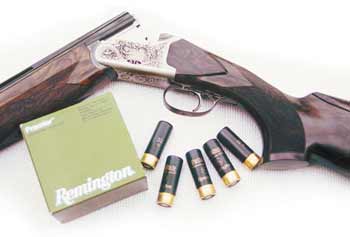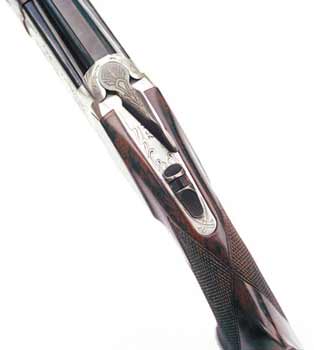Fabulous Fabarm STL VS Sporter
by John McDougall
Australian Shooter September 2004
 The Fabarm factory is located in Brescia, Italy, the heartland of the
Italian shotgun industry. This comparatively small production
manufacturer distributes to more than 45 countries worldwide and is
slowly gaining great acceptance in the marketplace.
The Fabarm factory is located in Brescia, Italy, the heartland of the
Italian shotgun industry. This comparatively small production
manufacturer distributes to more than 45 countries worldwide and is
slowly gaining great acceptance in the marketplace.
Fabarm’s latest sporting clays model, the STL VS, is a league above its predecessor, the Max Luxus, and has been launched with great innovation and many user-friendly modifications - such seems the commitment by Fabarm to their shotgun evolution. They have introduced state-of-the-art design, protective coatings and barrel design all combining to present a top quality shotgun without the premium price found with many other makers. Fabarm are beginning to stand alone with their innovations - with some great features sure to appeal to the most discerning of shotgunners.
The barrels
Unlike many other manufacturers, Fabarm mechanically bore the steel
stock from which their barrels are made. This is reported to offer less
stress than found with hammer-forged barrels, producing better patterns
and reduced recoil. The Tribore system of bore construction, where
there are three stages of differing bore constriction, is attributed
with improved pattern distribution, reduced recoil and improved pellet
penetration at all distances. As I have seen patterns from Tribore
barrels fired at Fabarm’s test range when I visited some years ago, I
can attest to these claims as being validated - their guns punish clay
targets.
The Tribore specifications are quite novel in dimension and begin with extra-long forcing cones leading into an oversized barrel at 18.8mm, (0.735"), before leading into a conical section about halfway down the barrel. This conical section at 18.4mm, leads into the choke, expands to cylinder bore for ten millimetres and then passes through 40mm of choke constriction. The 18.8mm section increases velocity, while the taper has the same effect as a garden hose when it is tightened - it compresses the shot column and potentially extends its range before the pellets pass through the choke - which determines the final pattern.
Offered in three barrel lengths, 28", 30" and 32", the barrels are meticulously profiled and topped with a newly designed rib, ventilated and tapered from ten millimetres to eight millimetres at the muzzle with a concave shape.
The provision of the HI VIZ sight system is also a welcome addition. This sight system allows the interchangeability of the front-sight to select the best sight for prevailing light conditions. (While many of us are unaware of using the front-sight, I must say the HI VIZ system was appreciated during my evaluation.) There are three ‘lite pipes’ of three differing colours that fit on an especially designed frame that also locks the pipes into position. The purpose of the fibre optic pipes is to collect and amplify available light so that the shooter is always aware of the muzzle position. While using the STL VS, I found this system extremely good.
 The 30" version I evaluated had eight Exis interchangeable choke tubes
supplied with the gun. These were a fifth-generation choke tube from
previous systems used by Fabarm and were clearly marked with their
choke constriction. They were easy to install/remove due to the collet
and T-bar choke spanner. The Exis choke tubes have additionally been
coated with a special PVD titanium preparation developed by Fabarm to
resist extreme atmospheric conditions and provide durable wear. Both
the Innerchokes and Exis choke tube systems manufactured by Fabarm are
now coated with this special application.
The 30" version I evaluated had eight Exis interchangeable choke tubes
supplied with the gun. These were a fifth-generation choke tube from
previous systems used by Fabarm and were clearly marked with their
choke constriction. They were easy to install/remove due to the collet
and T-bar choke spanner. The Exis choke tubes have additionally been
coated with a special PVD titanium preparation developed by Fabarm to
resist extreme atmospheric conditions and provide durable wear. Both
the Innerchokes and Exis choke tube systems manufactured by Fabarm are
now coated with this special application.
Blueing of the barrels was faultless. The gun looked great and the balance also felt fantastic. Although chambered for 76mm (3") I was unable to locate a steel shot proof mark on the monobloc, despite the Exis choke tubes being suited to steel shot (the Wetland camo model my son uses has the steel shot proof marks prominently stamped on its monobloc).
While on the monobloc and chamber area, it was interesting to note the four lumps used by Fabarm for their jointing (how the barrels and receiver are joined). The lumps are quite substantial and indicate a long and serviceable life before requiring attention. The replaceable trunnions in the receiver were also an added bonus should re-jointing ever be required. One feature missing from the new model was the jewel polishing about the monobloc. This is usually found on the better Fabarm guns for it assists with containing lubricants, thereby generally ensuring minimal wear and tear on the metal surfaces that come in contact.
The receiver
This has had a tasteful revamp from the Max Luxus model and featured a
flat-action side with engraving and ceramic inlays. When I visited
Fabarm they were experimenting with several designs and finishes on
their receivers - this is obviously a result of their innovative search
for a cost-effective but attractive finish. The gilt bordering was also
tastefully completed. One of the most striking modifications was the
newly designed and more ergonomic top lever. I could not help thinking
this was so similar to another Italian maker but in the evolution of
the STL I suppose such similarities are inevitable. It was certainly
more comfortable to operate. The newly designed top lever is also
coated with the PVD titanium application used on the choke tubes, to
provide a slick and smooth operation and to ensure less wear through
abrasion.
The triggerguard was generous in shape and featured the lion of Brescia on its underside. Many will welcome a newly designed six-position triggerfoot, an essential nowadays for shooter comfort. All wood-to-metal surfaces were extremely close, except for the rear of the triggerguard.
Overall, the receiver has undergone quite a deal of cosmetic and design improvement while maintaining the bifurcated jointing, the crux of many Italian gun designs. A design that provides for a lower profile, and in my opinion, a better balance and between-the-hands feel due to the lower centre of gravity. This is created by having the barrels pivot around a point almost halfway up the lower barrel, instead of using an under barrel hinge system.
 The stock and fore-end
The stock and fore-end
While I was sure the Fabarm stock and fore-end was made from walnut,
the TriWood finish made it difficult to ascertain the true character
and grain of the wood used. TriWood is reported to be a superior finish
that also seals the wood better, to prevent any movement resultant from
water or rain. The grain is accentuated through a number of darker
swirls that are applied to the stock and fore-end when they are sealed.
The chequering on both the stock and fore-end is laser-cut and provided
a firm and positive grip. The right-hand-side of the pistol grip also
featured a palm swell (the STL is also available in a left-hand
configuration). This provides for a firmer and fuller grip resulting in
better control.
An adjustable comb is standard on the STL VS and this is a welcome addition for it enables the shooter to set the gun precisely to the right drop-at-comb that is preferred. Given the wide variety of faces we all have, it is comforting to know we can have that added extra benefit for fine-tuning, to suit our particular style of shooting. A soft, interchangeable recoil pad was also fitted to complement the gun. This is always appreciated on either a field or sporting clays model to maintain the gun on your shoulder while shooting at high or overhead targets. There is nothing I detest more than a plastic buttplate.
The Schnabel (tulip) shaped fore-end was comfortable and was well-suited to the stock design. The fore-end iron was another part coated with the new PVD titanium finish, to avoid any excessive wear or abrasion.
In the field
Right from the start, the Fabarm STL VS looked the part. The TriWood
looked a little ‘false’ but I have to admit that when it comes to
shotgun woodwork I prefer a traditional, oiled finish. The TriWood
style of finish is being adopted nowadays by several gun manufacturers,
especially the high volume gunmakers, as good walnut becomes more
difficult to procure.
The 30" barrels were ideal and fitted with Exis modified in the top barrel and Exis Light modified in the lower barrel. I began the task of evaluating the gun’s performance at my local sporting clays ground. With the first station cleaned, I began to feel confident and after a myriad of targets over the next two stations, I began to feel as if the STL VS was custom-built, just for my benefit. I was soon to be humbled with a string of misses on more difficult targets but I was very impressed with the performance of the gun.
 True to form, the Fabarm chokes also punished the targets, not by just
chipping one here and there but by completely demolishing them. For the
evaluation I used a selection of Remington factory loads and several of
my own home loads. The results were the same, the chokes performed
exceptionally.
True to form, the Fabarm chokes also punished the targets, not by just
chipping one here and there but by completely demolishing them. For the
evaluation I used a selection of Remington factory loads and several of
my own home loads. The results were the same, the chokes performed
exceptionally.
A few friends who also used the gun were also suitably impressed. The gun was well-balanced, moved sprightly and the ensuing recoil from some brisk home loads was quite tame. The gun was truly a pleasure to shoot and as a bonus, at the end of the day I almost won my grade, which I felt was quite a feat using a gun straight-out-of-the-box for the first time.
I found the fluoro HIVIZ sights quite acceptable and can only assume that I was subconsciously putting the barrels where they needed to be in relation to the front-sight. This is an autonomic response, for the only real thing I am focused on when shooting is the target. The gun was an excellent fit for me without the need to adjust the comb; I must fall into the ‘Mr Average’ category, for most guns I test nowadays seem well-configured for my build.
I really enjoyed shooting the STL VS from Fabarm. At the end of the day I was not suffering any adverse effects from recoil after 60 targets and the gun swung through targets effortlessly. I believe that during the two rounds of competition, as part of my evaluation of the STL, every target on the layout was pulverised - unfortunately, just not all in the one round.
For someone who seeks to spend less than $3500 for a quality gun with a full complement of choke tubes and a great ABS plastic case, I believe you can’t go beyond the Fabarm STL VS, especially if you prefer a low profile bifurcated-jointed gun.
During the past six years since I have had the opportunity of shooting and evaluating Fabarm shotguns; I can say without fear of contradiction, they just get better every time. Good luck and safe shooting!
